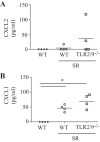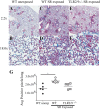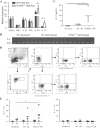Chronic hypersensitivity pneumonitis caused by Saccharopolyspora rectivirgula is not associated with a switch to a Th2 response
- PMID: 26719148
- PMCID: PMC4773842
- DOI: 10.1152/ajplung.00305.2015
Chronic hypersensitivity pneumonitis caused by Saccharopolyspora rectivirgula is not associated with a switch to a Th2 response
Abstract
Hypersensitivity pneumonitis (HP) is an immune-mediated interstitial lung disease that develops following repeated exposure to inhaled environmental antigens. The disease results in alveolitis and granuloma formation and may progress to a chronic form associated with fibrosis; a greater understanding of the immunopathogenic mechanisms leading to chronic HP is needed. We used the Saccharopolyspora rectivirgula (SR) mouse model of HP to determine the extent to which a switch to a Th2-type immune response is associated with chronic HP. Exposure of wild-type (WT) and tlr2/9(-/-) mice to SR for 14 wk resulted in neutrophilic and lymphocytic alveolitis that was not dependent on Toll-like receptors (TLRs) 2 and 9. Long-term exposure of WT mice to SR resulted in a significant increase in collagen deposition, protein leakage, and IL-1α accompanied by a decrease in quasistatic compliance and total lung capacity compared with unexposed mice. This was associated with an increase in IL-17 but not IL-4 production or recruitment of Th2 cells. tlr2/9(-/-) mice exhibited an increase in protein leakage but less IL-1α and collagen deposition in the lungs compared with WT mice, yet they still displayed a decrease in quasistatic compliance, although total lung capacity was not affected. These mice exhibited an increase in both IL-13 and IL-17, which suggests that IL-13 may ameliorate some of the lung damage caused by long-term SR exposure. Our results suggest that lung pathology following long-term SR exposure in WT mice is associated with the IL-17 response and that TLRs 2 and 9 may inhibit the development of the IL-13/Th2 response.
Keywords: Toll-like receptors 2 and 9; fibrosis; hypersensitivity pneumonitis.
Copyright © 2016 the American Physiological Society.
Figures






Similar articles
-
Protein kinase D1 in myeloid lineage cells contributes to the accumulation of CXCR3+CCR6+ nonconventional Th1 cells in the lungs and potentiates hypersensitivity pneumonitis caused by S. rectivirgula.Front Immunol. 2024 Oct 11;15:1403155. doi: 10.3389/fimmu.2024.1403155. eCollection 2024. Front Immunol. 2024. PMID: 39464896 Free PMC article.
-
TLR2 regulates neutrophil recruitment and cytokine production with minor contributions from TLR9 during hypersensitivity pneumonitis.PLoS One. 2013 Aug 30;8(8):e73143. doi: 10.1371/journal.pone.0073143. eCollection 2013. PLoS One. 2013. PMID: 24023674 Free PMC article.
-
Inflammatory response and dynamics of lung T cell subsets in Th1, Th2 biased and Th2 deficient mice during the development of hypersensitivity pneumonitis.Exp Mol Pathol. 2010 Jun;88(3):407-15. doi: 10.1016/j.yexmp.2010.03.002. Epub 2010 Mar 16. Exp Mol Pathol. 2010. PMID: 20298687
-
Hypersensitivity pneumonitis caused by fungi.Proc Am Thorac Soc. 2010 May;7(3):229-36. doi: 10.1513/pats.200906-041AL. Proc Am Thorac Soc. 2010. PMID: 20463253 Review.
-
[Immunopathogenesis of extrinsic allergic alveolitis].Immun Infekt. 1995 Jun;23(3):86-91. Immun Infekt. 1995. PMID: 7615307 Review. German.
Cited by
-
IL-17 in the lung: the good, the bad, and the ugly.Am J Physiol Lung Cell Mol Physiol. 2018 Jan 1;314(1):L6-L16. doi: 10.1152/ajplung.00344.2017. Epub 2017 Aug 31. Am J Physiol Lung Cell Mol Physiol. 2018. PMID: 28860146 Free PMC article. Review.
-
Protein kinase D1 in myeloid lineage cells contributes to the accumulation of CXCR3+CCR6+ nonconventional Th1 cells in the lungs and potentiates hypersensitivity pneumonitis caused by S. rectivirgula.Front Immunol. 2024 Oct 11;15:1403155. doi: 10.3389/fimmu.2024.1403155. eCollection 2024. Front Immunol. 2024. PMID: 39464896 Free PMC article.
-
Mir-155-5p targets TP53INP1 to promote proliferative phenotype in hypersensitivity pneumonitis lung fibroblasts.Noncoding RNA Res. 2024 Mar 11;9(3):865-875. doi: 10.1016/j.ncrna.2024.02.010. eCollection 2024 Sep. Noncoding RNA Res. 2024. PMID: 38586316 Free PMC article.
-
5-methyladenosine regulators play a crucial role in development of chronic hypersensitivity pneumonitis and idiopathic pulmonary fibrosis.Sci Rep. 2023 Apr 12;13(1):5941. doi: 10.1038/s41598-023-32452-4. Sci Rep. 2023. PMID: 37045913 Free PMC article.
-
Novel acute hypersensitivity pneumonitis model induced by airway mycosis and high dose lipopolysaccharide.Respir Res. 2021 Oct 10;22(1):263. doi: 10.1186/s12931-021-01850-5. Respir Res. 2021. PMID: 34629055 Free PMC article.
References
-
- Agostini C, Trentin L, Facco M, Semenzato G. New aspects of hypersensitivity pneumonitis. Curr Opin Pulm Med 10: 378–382, 2004. - PubMed
-
- Ando M, Suga M. Hypersensitivity pneumonitis. Curr Opin Pulm Med 3: 391–395, 1997. - PubMed
-
- Barrera L, Mendoza F, Zuniga J, Estrada A, Zamora AC, Melendro EI, Ramirez R, Pardo A, Selman M. Functional diversity of T cell subpopulations in subacute and chronic hypersensitivity pneumonitis. Am J Respir Crit Care Med 177: 44–55, 2008. - PubMed
Publication types
MeSH terms
Substances
Grants and funding
LinkOut - more resources
Full Text Sources
Other Literature Sources
Molecular Biology Databases
Research Materials
Miscellaneous

